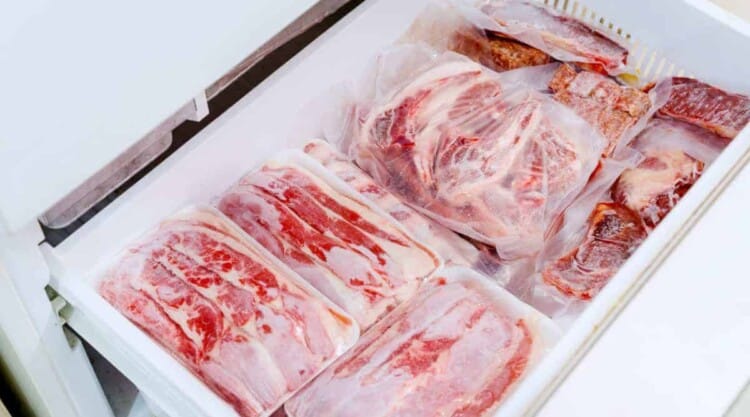In todays comprehensive article, How to Store Meat Safely, youll never have to worry about taking chances or wasting your money on spoiled meat again!
If you are a meat lover, it is important to know how to protect your health by storing meat safely and correctly.
If you have invested in a Side of Beef / CSA Cow Share, we will teach you how to protect your side of beef during its time in the freezer and what to look out for.
Not only will this ensure that the beef, pork, chicken, fish, lamb or mutton you just bought doesnt go bad before you can use it, but it will also keep your family safe from food poisoning.
Raw meat, poultry and fish should be stored in the following top-to-bottom order in the refrigerator: whole fish, whole cuts of beef and pork, ground meats and fish, and whole and ground poultry. Wrap food properly before storing it. Leaving food uncovered can lead to cross- contamination.

How to Store Meat Safely in the Fridge?
When it comes to keeping meat, the fridge is your best friend by far.
The key temperature threshold to keep your meat safely stored in the fridge is 38F to 40F (3.3C to 4.4C).
Always store fresh meats covered and on a separate fridge shelf from all other items,
Familiarize your fridge settings in the owner’s manual to ensure you set your temperatures correctly. It is also a good idea to periodically test the internal temperature of your fridge with a digital thermometer to ensure accuracy and safety.
Bear in mind that some cuts and varieties of ground beef can only be kept fresh for a limited period.
Most uncooked fresh meats will keep for up to 3-5 days; however, organ meats such as liver and kidney should only be kept for around two days at most.
Vacuum packaged steaks will keep in the fridge for 3 days.
Raw Suet for example will keep for 5 days maximum
Always store cooked meat like beef or lamb leftovers for example in a covered container and always a separate shelf from raw meat/raw fish which should also be in a covered container.
Historical Methods of Storing and Preserving Meat
Long before man learned how to harness ice commercially to refrigerate or freeze meat, we have been successfully preserving meats in several time-honored methods which include:
- Salting
- Brining
- Wind Drying
- Sun Drying
- Dry Aging
- Curing
- Smoking
- Pickling
- Canning
- Marinating
How to Store a Year’s Worth of Meat
FAQ
What are the storage requirements for meat?
|
Food
|
Type
|
Refrigerator [40°F (4°C) or below]
|
|
Hamburger, ground meats and ground poultry
|
Hamburger, ground beef, turkey, chicken, other poultry, veal, pork, lamb, and mixtures of them
|
1 to 2 days
|
|
Fresh beef, veal, lamb, and pork
|
Steaks
|
3 to 5 days
|
|
|
Chops
|
3 to 5 days
|
|
|
Roasts
|
3 to 5 days
|
What are the storage practices for meat?
How do you keep meat from going bad?
How should raw meat be stored on shelves?
How long can meat be stored?
Man has been preserving meats for long-term storage for hundreds of years. All meats must be stored safely at a temperature that will keep them either refrigerated for a few days or frozen for a few months. Be especially careful of cooked meat which is still rare such are rare lamb.
Which meats should one avoid?
You should limit or avoid processed meat products such as sausages, salami, pate and beefburgers, because these are generally high in fat and salt. Also limit meat products in pastry, such as pies and sausage rolls. Choose lean cuts, if you are buying pre-packed meat, check the nutrition label to see how much fat it contains and compare products. Prepare turkey and chicken without the skin, as these are lower in fat (or remove the skin before cooking).
How do you store cooked meat?
Place it on a plate or in a shallow pan to catch any drippings and avoid cross-contamination. Cooked meats should also be tightly wrapped or placed in airtight containers. In the freezer For long-term storage, freezing meat is a great option.
